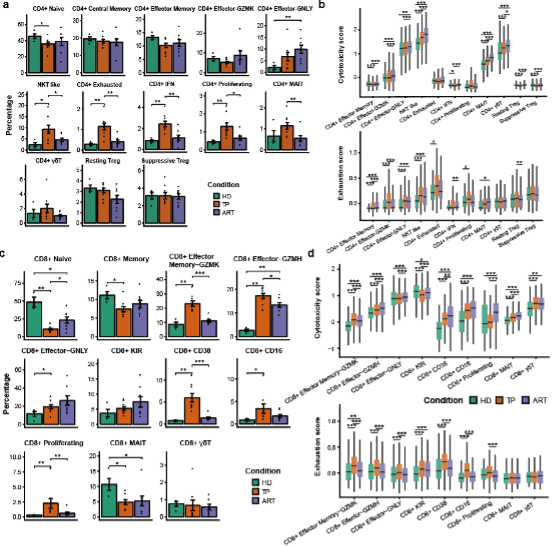
Cell Discovery | Global transcriptomic characterization of T cells in individuals with chronic HIV-1 infection
The infection of human immunodeficiency virus (HIV) is a vital global public health issue. HIV is a retrovirus that attacks the human immune system, which was first discovered in the United States in 1981 [1]. Leaving untreated, the number of CD4+ T cells in HIV-1 infected individuals will gradually decrease, and the immune system of HIV-1 infected individuals will gradually lose function until collapse, eventually develop into the acquired immune deficiency syndrome (AIDS).
During HIV infection, CD4+ T cells are the main target cells attacked by HIV, and CD8+ T cells are the main cells that play an antiviral role [2]. Currently, the primary clinical indicator for judging the disease progression and the efficacy of antiretroviral therapy (ART) after HIV infection is the number of CD4+ T cells and the ratio of CD4+ T cells to CD8+ T cells. It has been reported that the loss of CD4+ T cells and the dysfunction of CD8+ T cells play a very important role in the progression of AIDS. However, T cells are composed of many highly specialized subsets with different immune functions. It is worth exploring how the composition and transcriptomic profiles of whole T-cell subsets are altered and how these alterations influence T cell immune recovery and clinical outcome in participants during ART.
On Mar. 29th, 2022, Fan Bai’s Lab from Biomedical Pioneering Innovation Center (BIOPIC) and Beijing Advanced Innovation Center for Genomics (ICG), in collaboration with Fusheng Wang’s Group at Fifth Medical Center of Chinese PLA General Hospital, published a paper titled “Global transcriptomic characterization of T cells in individuals with chronic HIV-1 infection” on Cell Discovery, which systematically explored the immunological characteristics and alterations of T-cell subsets during chronic HIV-1 infection at the single-cell level.

The single-cell RNA sequencing and paired single-cell T cell receptor (TCR) sequencing were performed on the peripheral T cells of 14 individuals with chronic human immunodeficiency virus 1 (HIV-1) infection, including 9 treatment-naïve (TP) and 8 antiretroviral therapy (ART) participants (among whom 3 were paired with TP cases). Then compared the results with 4 healthy donors (HD)(Fig.1). By using this approach, researchers illustrated marked changes in T-cell composition, molecular pathways and functional features in individuals with chronic HIV-1 infection with or without ART.

Fig.1 Study design and single-cell transcriptional profiling of CD4+ and CD8+ T cells from HDs and chronic HIV-1-infected individuals.
Meanwhile, researchers revealed abnormal global changes in the CD4+ and CD8+ T cells in the TPs, including a significant loss of naïve CD4+ and CD8+ T-cell subsets, yet a profound increase in CD4+ and CD8+ T-cell subsets with high cytotoxicity and clonal expansion or proliferating features. The proportions of effector-state T-cell subsets decreased after ART, but the proportions of naïve-state T-cell subsets could not return to the normal levels detected in the HDs. Of particular interest, the percentages of the CD4+ Effector-GNLY subset and CD8+ Effector-GNLY subset were further increased after ART (Fig.2).

Fig.2 Immunological features of T-cell subsets across the three conditions.
Hierarchical clustering based on T cell compositions in the HDs and individuals with chronic HIV-1 infection yielded three groups (Fig. 3). It is worth noting that HIV-1 infected individuals after ART were divided into two groups with good and poor prognosis. Here, researchers found that CD4+ Effector-GNLY and CD8+ Effector-GNLY subset might be correlated with poor immune restoration of HIV-1 infected individuals after ART.

Fig.3 Clinical implications of GNLY+ effector T cells in chronic HIV-1-infected individuals.
In summary, this work comprehensively portrayed the global landscape of peripheral T cells and the immune responses in chronic HIV-1-infected individuals., and revealed the effects of ART on T cells. This transcriptional data set enables deeper understanding of the immune responses during HIV-1 infection. It is also a rich resource for developing novel immunity-targeted therapeutic strategies.
Ph.D. candidate Xiangming Wang, Dr. Xudong Xing from Biomedical Pioneering Innovation Center, School of Life Sciences of Peking University, Dr. Jiyuan Zhang and Dr. Huihuang Huang from Fifth Medical Center of Chinese PLA General Hospital are the co-first authors of this paper. Professor Fan Bai from Beijing Advanced Innovation Center for Genomics, Biomedical Pioneering Innovation Center, School of Life Sciences of Peking University and professor Fusheng Wang from Fifth Medical Center of Chinese PLA General Hospital are corresponding authors. This work was supported by Peking University Clinical Scientist Program (BMU2019LCKXJ013) from the Fundamental Research Funds for the Central Universities, and National Natural Science Foundation Innovation Research Group Project (81721002).
Link: https://www.nature.com/articles/s41421-021-00367-x
References:
[1] Gottlieb, M.S. et al. Pneumocystis carinii pneumonia and mucosal candidiasis in previously healthy homosexual men: evidence of a new acquired cellular immunodeficiency. N Engl J Med. 305, 1425-1431(1981).
[2] Deeks, S.G. et al. HIV infection. Nat Rev Dis Primers. 1, 15035(2015).